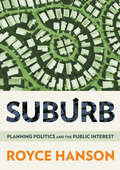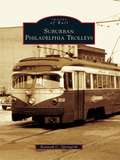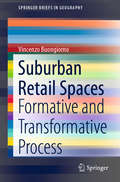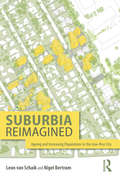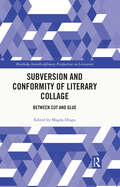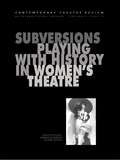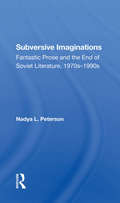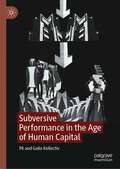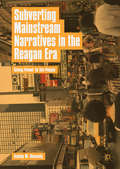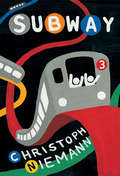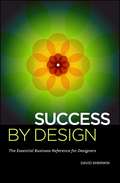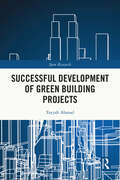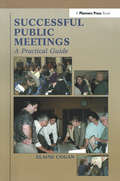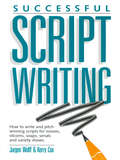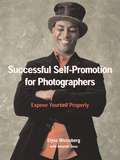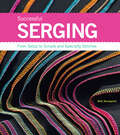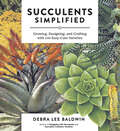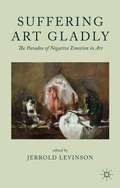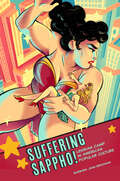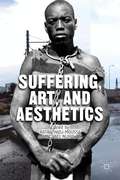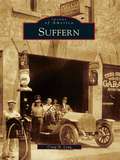- Table View
- List View
Suburb: Planning Politics and the Public Interest
by Royce HansonLand-use policy is at the center of suburban political economies because everything has to happen somewhere but nothing happens by itself. In Suburb, Royce Hanson explores how well a century of strategic land-use decisions served the public interest in Montgomery County, Maryland, a suburb of Washington, D.C. Transformed from a rural hinterland into the home a million people and a half-million jobs, Montgomery County built a national reputation for innovation in land use policy—including inclusive zoning, linking zoning to master plans, preservation of farmland and open space, growth management, and transit-oriented development.A pervasive theme of Suburb involves the struggle for influence over land use policy between two virtual suburban republics. Developers, their business allies, and sympathetic officials sought a virtuous cycle of market-guided growth in which land was a commodity and residents were customers who voted with their feet. Homeowners, environmentalists, and their allies saw themselves as citizens and stakeholders with moral claims on the way development occurred and made their wishes known at the ballot box. In a book that will be of particular interest to planning practitioners, attorneys, builders, and civic activists, Hanson evaluates how well the development pattern produced by decades of planning decisions served the public interest.
Suburban Form: An International Perspective
by Kiril Stanilov Brenda Case ScheerThis book examines and documents the remarkable development and transformation of suburban form throughout the globe during the twentieth century. The premise that suburban areas are monotonous, inert environments is put to a test through investigation of the complexity of those suburban settings and the dynamic physical changes that have taken place since their inception.
Suburban Philadelphia Trolleys
by Kenneth C. SpringirthThe Philadelphia Suburban Transportation Company prospered through the hard times of the 1930s and was the last privately-owned trolley system in the United States. Aerodynamically designed Bullet cars of the Philadelphia and Western Railway dramatically reduced travel time on the Sixty-ninth Street toNorristown line. The Presidents' Conference Committee trolley cars of the Philadelphia Transportation Company linked the boroughs of Darby, Colwyn, and Yeadon with Philadelphia. Photographs of Media's 1977 town fair feature vintage trolleys in the only suburban community in the United States with a trolley line ending in its main street. Suburban Philadelphia Trolleys covers the history of the trolleys that served Philadelphia's western suburbs.
Suburban Remix: Creating the Next Generation of Urban Places
by David Dixon Jason BeskeThe suburban dream of a single-family house with a white picket fence no longer describes how most North Americans want to live. The dynamics that powered sprawl have all but disappeared. Instead, new forces are transforming real estate markets, reinforced by new ideas of what constitutes healthy and environmentally responsible living. Investment has flooded back to cities because dense, walkable, mixed-use urban environments offer choices that support diverse dreams. Auto-oriented, single-use suburbs have a hard time competing.Suburban Remix brings together experts in planning, urban design, real estate development, and urban policy to demonstrate how suburbs can use growing demand for urban living to renew their appeal as places to live, work, play, and invest. The case studies and analyses show how compact new urban places are already being created in suburbs to produce health, economic, and environmental benefits, and contribute to solving a growing equity crisis.Above all, Suburban Remix shows that suburbs can evolve and thrive by investing in the methods and approaches used successfully in cities. Whether next-generation suburbs grow from historic village centers (Dublin, Ohio) or emerge de novo in communities with no historic center (Tysons, Virginia), the stage is set for a new chapter of development—suburbs whose proudest feature is not a new mall but a more human-scale feel and form.
Suburban Retail Spaces: Formative and Transformative Process (SpringerBriefs in Geography)
by Vincenzo BuongiornoThis book derives from observations of the contemporary built environment and its contradictions. The suburban retail spaces, specifically the suburban shopping mall, and the changes caused by them within urban organisms are the object of the investigation synthesized in the volume. The topic is very crucial for the development of the contemporary city. It constitutes at the same time a problem (large commercial structures' spread is 'destroying' traditional commercial urban fabrics) and an opportunity (shopping malls are the most vital parts of the new suburbs and can play the role of community nucleus in urban and suburban areas). Furthermore, the spread of e-commerce forces these structures to functional and spatial transformations that brings also a new relationship with the city.The analytical reading, supplemented by generative and design projections, is carried out by using the conceptual and methodological tools of urban morphology, specifically those of the typological processual approach. From this specific point of view, the suburban shopping mall is read as an organism (a complex system characterized by mutual solidarity and interdependence among component elements) in itself, and as a sub-organisms belonging to the largest territorial organism.The book is intended to offer, to operators, scholars, researchers, professionals and students, a reading and design method, to interpret an important aspect of the contemporary built environment by analyzing the suburban commercial space case. It offers at the same time a model applicable to other specific not-commercial cases, to defining paths for further research and design developments.
Suburbia Reimagined: Ageing and Increasing Populations in the Low-Rise City
by Nigel Bertram Leon van SchaikWorldwide, more and more people are living in cities, with suburbs conceived as appendages to the city, rather than being part of the city system, which is densely populated and offers a full range of services. But suburbs are not the city spread too thin, and in fact hold potential for a lived complexity as satisfying as that assumed to be available in inner cities. Just as the ecological function of wetlands was ignored by modernist planning, and swamps once-drained are now recognised as vital to water cycles, suburbs are increasingly recognised as part of a city’s wellbeing with their own alternative ideology and opportunities for urbanity and ecological sustainability. Suburbia Reimagined shows how such subdivision structures can offer new possibilities for sustainably integrating living between generations and between established and arriving migrant communities. The authors worked locally and internationally with university campuses, shopping centres, hospitals, airports, and other large entities spread through suburbia, to identify a broad range of suburban situations that have been modified to ensure that residents have a full access to amenities and services. The book addresses the history and design of suburbia, from the post-war soldier settlements of the 40s and 50s to the university hinterlands of Silicon Valley in order to reappraise the locked potential within such subdivision patterns. The authors propose a new model forward, examining case studies ranging from repurposed malls and railways for ecological sustainability to cul-de-sacs as social units and post-industrial factory conversions, ultimately showing the nascent patterns in suburbia that have the potential to support a rich life for all age groups.
Subversion and Conformity of Literary Collage: Between Cut and Glue (Routledge Interdisciplinary Perspectives on Literature)
by Magda DraguSubversion and Conformity of Literary Collage: Between Cut and Glue fills a gap in the current scholarship on literary collage, by addressing how different the interpretations of the concept are, depending on the author who uses the concept and the material and writers surveyed. The book studies writers who employed literary collage during the twentieth and twenty-first centuries, some whose works have been intensely analyzed from this perspective (William S. Burroughs and Walter Benjamin), but also some whose collage-writing style has recently been investigated by writers, being usually placed under the umbrella term of artist books (Stelio Maria Martini).
Subversions
by Julie Wilkinson Gabriele Griffin Erika BlockFirst Published in 1998. Routledge is an imprint of Taylor & Francis, an informa company.
Subversive Esotericism and Aesthetic Radicalism: The Myths and Rituals of Viennese Actionism (Palgrave Studies in New Religions and Alternative Spiritualities)
by Sólveig GuðmundsdóttirIn this book, Sólveig Guðmundsdóttir uncovers the crucial role of esotericism in the art of the Vienna Actionists—a group of Austrian neo-avant-garde artists, infamous for their transgressive performance art. Addressing this frequently overlooked aspect of Actionism, Guðmundsdóttir traces, historicizes, and examines the esoteric discourses in selected works: the collective manifesto Die Blutorgel (1962), Rudolf Schwarzkogler’s text Das Ästhetische Panorama (1967/68) and the performances Abreaktionsspiel (1970) by Hermann Nitsch, and Zerreißprobe (1970) by Günter Brus. Mapping out the various discursive entanglements as they appear in the works, i.e. between esotericism and psychoanalysis, fascism, gender, sexuality, aesthetics, science, orientalism and religious discourses, the author illustrates and establishes the importance of esoteric traditions for the Actionists’ art and subversive practices. The historical analysis of the artworks reflects on the cultural nexus of post-war Austria, as well as the relations between radical politics, countercultures and esotericism, and how they appear in Actionism. Guðmundsdóttir argues that to survey the historical placement of esotericism is vital for understanding not only the context of their works, but also the contradictory image of the Actionists as both anti-authoritarian and reactionary artists.
Subversive Imaginations: Fantastic Prose And The End Of Soviet Literature, 1970s-1990s
by Nadya PetersonIn response to the profound changes in Soviet society in recent years, the author considers the demise of Soviet literature and the emergence of its Russian progeny through the prism of the writers' engagement with fantasy. Viewing the mutual interaction of Soviet/Russian literary output with aspects of the dominant culture such as ideology and politics, Nadya Peterson traces the process of mainstream literary change in the context of broader social change. She explores the subversive character of the fantastic orientation, its Utopian and apocalyptic motifs, and its dialogical relationship with socialist realism, as it steadily gathered force in the latter Soviet decades. The shattering of the mythic colossus did not put an end to these opposing forces, but rather diverted them in various unexpected directions–as the author explains in her concluding chapters on the new "alternative" literatures.
Subversive Performance in the Age of Human Capital
by Pil Kollectiv Galia KollectivContemporary art relies on an expansionist, modernist ideal and still progresses through a critique of earlier forms of democratisation. But beneath this democratic drive, lurks a creeping crisis. Under neoliberalism, criticality has become a zone of value production. A self-deprecating irony, exposing and re-enacting this position of impotence, is one of the few gestures left in the arsenal of critical art. Against this irony, this book pits overidentification. This term has been taken to mean a kind of parodic mimicry of institutional power. Using a broad tapestry of sources, from political philosophers to art theorists, from post-Marxist critiques of labour to ethnographic studies, it proposes an interpretation of overidentification that does not collapse into ironic posturing. The authors differentiate this from bad faith flirting with taboo aesthetics by focusing on practices grounded in a genuine identification with power that ushers the kind of excess implied by overidentification. It is these forms of overidentification that destabilise the metastasis of liberal-democracy. Staging forms of critique not so readily absorbed into the structure of the present, these subversive performances herald a future beyond the democratic paradox.
Subverting Mainstream Narratives in the Reagan Era: Giving Power To The People
by Ashley M. DonnellySubverting Mainstream Narratives in the Reagan Era explores how artists, novelists, and directors were able to present narratives of strong dissent in popular culture during the Reagan Era. Using but subverting the tools of mainstream novels and films, these visionaries’ works were featured alongside other books in major bookstores and promoted alongside blockbusters in movie theatres across the country. Ashley M. Donnelly discusses how the artists accomplished this, why it is so important, and how new artists can use these techniques in today’s homogenous and mundane media.
Subway
by Christoph NiemannSpeed. Color. Sound. Numbers. Maps. Connections. Navigation. Subway systems may be specific to certain cities around the world, but the pure thrill of a subway ride is universal to all young children.Christoph Niemann’s graphically elegant and playful picture book is a tour de force for preschoolers and a stellar addition to the canon of books about trains, trucks, planes, and automobiles.Based on the author’s own underground adventures with his young boys—chronicled for adult readers in Niemann’s New York Times blog, Abstract City—this innovative picture book is an invitation down underground, where a system of trains and tracks delivers millions of riders to their destinations each day.“Underneath the city is this beautifully simple system of letters, numbers, and colors. The trains and stations are huge and impressive but also comforting, because nothing ever changes. My boys are in charge; they can read the signs, navigate the grid, and they always know what happens next.”—Christoph Niemann
Success By Design: The Essential Business Reference for Designers
by David SherwinWant to make your design business a success? Start here.Fellow Designer,In your career you may have been like me: Trying to keep projects on the rails and clients happy. Digging through blogs for useful advice. Wondering if there was a better way to handle all of the demands of being a design professional and running a creative business.The wisdom contained in Success By Design: The Essential Business Reference for Designers will help you become a stronger businessperson and better plan your career path as a design leader. This book was born from in-depth interviews with a slew of successful designers, studio directors, project managers, and client service professionals across a wide range of creative industries.It contains the business secrets I needed the most when I started as a designer sixteen years ago.--David
Successful Development of Green Building Projects (Spon Research)
by Tayyab AhmadFocusing on office buildings, this book explores how green building development can be managed to achieve successful project outcomes. The book starts by highlighting the special requirements of green buildings which distinguish them from traditional buildings. The book then presents a detailed discussion of the success conditions for green building projects. Highlighting 73 success conditions which have been categorized within 20 broad themes, the book reports on the findings from interviews with Green Building stakeholders from Australia, Hong Kong, Pakistan, Singapore, the United Arab Emirates, and the United Kingdom. The book demonstrates how the complexity, design methodology, and team collaboration prevalent in the delivery of successful green buildings sets them apart from traditional building projects. The book also demonstrates that success in green building delivery is generally associated with socio-technical conditions. The research reported in this book will allow project decision-makers such as clients and project team members to consider the wide range of identified success conditions to optimise project performance across its development stages and achieve successful project outcomes. Theoretically, the findings can inform future research focused on green building development, resulting in the more efficient development of green building projects that can reduce the effects of climate change and resource depletion.
Successful Public Meetings, 2nd ed.: A Practical Guide (Jossey-bass Public Administration Ser.)
by Elaine CoganThe author explains why it's essential to begin the preparations by deciding what the meeting is intended to accomplish. That, in turn, determines what kind of meeting you should conduct: informational, advisory, or problem-solving. The author breaks down the essential tasks involved and even suggests the right type of person to handle each one. She describes various types of troublesome meeting attendees-from accusers and apathetics to fence-sitters and know-it-alls-and offers advice on how to deal tactfully but firmly with them all. The author also tackles working effectively with the media, a subject that terrifies most planners. True stories of public meetings, both good and bad, add humor to her no-nonsense narrative. Follow her step-by-step checklist and leave nothing to chance."
Successful Scriptwriting: How to write and pitch winning scripts for movies, sitcoms, soaps, serials and v ariety shows
by Jurgen Wolff Kerry CoxSUCCESSFUL SCRIPTWRITINGLet's start with "The End." The credits roll - we see "Screenplay by ..." and there's your name. The show's a hit! It's Emmy/Oscar night, and you're seated up front. The nominations are revealed; your name is called. Your acceptance speech is memorable, an inspiration to the new writers "breaking in." Variety says your "future looks very bright." Hooray for Hollywood! But how did you get here?With talent, determination, and the help of this comprehensive guide, you'll have the wherewithal to move your dream from your mind onto the page and to succeed in this fiercely competitive, highly selective field.Starting with a basic course in scriptwriting, Jurgen Wolff and Kerry Cox teach you the fundamental skills of writing the feature film script, from original idea to finished screenplay. Then you'll learn how to apply your new-found skills to every type of television and film script: movies-of-the week, episodic television, situation comedies and soap operas.You'll also find helpful insight from the greats in the business, like Colin Higgins (Harold and Maude, Foul Play, 9 to 5), Larry Gelbart (Oh, God!, Tootsie, "M*A*S*H"), William Bickley ("Perfect Strangers," "Happy Days"), and Steven Bochco ("Doogie Howser, M.D.," "L.A. Law"). And you'll find answers to these essential questions:What fundamental skills and essential ingredients do I need to write a feature film script?By what criteria do producers and studios evaluate scripts or ideas presented to them?When should I write an outline or a treatment for my script, and what are the formats?How do I go about protecting my work?Is there a cut-and-dried technique for pitching my ideas?Every part of this book reflects the needs and realities of today's TV and film industry, providing you with insight as well as practical knowledge. With this book as your guide, you can start at the beginning and follow a well-defined path to successful scriptwriting.
Successful Self-Promotion for Photographers: Expose Yourself Properly
by Amanda Sosa Elyse WeissbergThere's much more to being a professional photographer than simply taking great pictures. Today's self-employed photographers must have marketing savvy to spare. This guide from a widely known and respected industry insider provides that--and much more.In Successful Self-Promotion for Photographers, freelance photographers learn what they must do to improve their skills after the pictures have been developed. Featuring sections such as "Focus Your Image," "Sharpen Your Client Focus," "Identify Your Market," and the ever-important "Spot Trends," here are dozens of surefire strategies for selling services, staying on top of the latest market trends, and winning enough high-paying work to survive and thrive in this very competitive business. For any photographer looking to make it big behind the lens, this indispensable reference shows how to get the right exposure every time.
Successful Serging: From Setup to Simple and Specialty Stitches
by Beth BaumgartelAn easy-to-use guide to all you need to know about using a serger machine, including thread & stitch selection and stitching & construction techniques.This “at your fingertips” reference contains hundreds of techniques and tips for making the most of the serger, or overlock, machine—a versatile and speedy tool for stitching garments and home decor.Readers will learn how the serger works, the many styles available, and the variety of functional and decorative stitches possible. There are also easy-to-find-and-follow charts—of thread choices, must-have accessories, and best stitches for a range of fabric types. This book is an easy-reference collection of basic techniques, tips, and helpful information for anyone who is learning about or already owns a serger.
Successful Sewing
by Mary G. WestfallTextbook designed for use by beginning and experienced sewing students.
Succulents Simplified: Growing, Designing, and Crafting with 100 Easy-Care Varieties
by Debra Lee BaldwinSucculents are hot. And Debra Lee Baldwin, the bestselling author of Designing with Succulents and Succulent Container Gardens, is the ideal guide for gardeners, crafters, and DIYers looking for an introduction to these trendy, low-maintenance, drought-tolerant plants. Along with gorgeous photos packed with design ideas, Debra offers her top 100 plant picks and explains how to grow and care for succulents no matter where you live. Step-by-step projects, including a cake-stand centerpiece, special-occasion bouquets, a vertical garden, and a succulent topiary sphere, will inspire you to express your individual style. Whether you’re a novice or veteran, have an acre to fill or a few pots, live in Calexico or Canada, Succulents Simplified is a dazzling primer for success with succulents wherever you live!
Suffering Art Gladly
by Jerrold LevinsonSuffering Art Gladly is concerned with the ostensibly paradoxical phenomenon of negative emotions involved in the experience of art: how can we explain the pleasure felt or satisfaction taken in such experience when it is the vehicle of negative emotions, that is, ones that seem to be unpleasant or undesirable, and that one normally tries to avoid experiencing? The question is as old as philosophical reflection on the arts, beginning with Plato and Aristotle, and subsequently addressed by Hume, Burke, Diderot, Kant, and Schopenhauer, among others. Moreover, it is still an important and unresolved question in contemporary philosophy of art, where the discussion has been notably enlivened by recent research on the nature of imagination, cognition, and the emotions. Suffering Art Gladly comprises essays of two kinds, though the division between them is not airtight. The first kind are essays with a primarily historical focus, examining the problem of negative emotion from art as treated by important figures in the history of aesthetic thought, including Aristotle, Hume, Diderot, Kant, and Schopenhauer. The second kind are essays with a primarily contemporary focus, in which the methods and tools of contemporary analytic philosophy are much in evidence. In addition to the thirteen essays forming the heart of the book there is a general introduction by the editor, motivating the basic problem with which the essays are variously concerned and identifying the presuppositions or assumptions that are involved in different solutions to the problem. The individual essays are wide-ranging, dealing with a variety of artforms, negative emotions, and specific works of art, and the contributors, all recognized scholars in the field of aesthetics, are a mixture of junior and senior figures representing seven nationalities.
Suffering Sappho!: Lesbian Camp in American Popular Culture
by Barbara Jane BrickmanAn ever-expanding and panicked Wonder Woman lurches through a city skyline begging Steve to stop her. A twisted queen of sorority row crashes her convertible trying to escape her queer shame. A suave butch emcee introduces the sequined and feathered stars of the era’s most celebrated drag revue. For an unsettled and retrenching postwar America, these startling figures betrayed the failure of promised consensus and appeasing conformity. They could also be cruel, painful, and disciplinary jokes. It turns out that an obsession with managing gender and female sexuality after the war would hardly contain them. On the contrary, it spread their campy manifestations throughout mainstream culture. Offering the first major consideration of lesbian camp in American popular culture, Suffering Sappho! traces a larger-than-life lesbian menace across midcentury media forms to propose five prototypical queer icons—the sicko, the monster, the spinster, the Amazon, and the rebel. On the pages of comics and sensational pulp fiction and the dramas of television and drive-in movies, Barbara Jane Brickman discovers evidence not just of campy sexual deviants but of troubling female performers, whose failures could be epic but whose subversive potential could inspire. Supplemental images of interest related to this title: George and Lomas; Connie Minerva; Cat On Hot Tin; and Beulah and Oriole.
Suffering, Art, and Aesthetics
by Michael Nijhawan Ratiba Hadj-MoussaHow do we conceptualize the relationship between suffering, art, and aesthetics from within the broader framework of social, cultural, and political thought today? This book brings together a range of intellectuals from the social sciences and humanities to speak to theoretical debates around the questions of suffering in art and suffering and art.
Suffern
by Craig H. LongSuffern, incorporated in 1896, is the gateway to the Ramapo Pass. Thirty miles from New York City, the village is at the confluence of several major interstate highways and the Ramapo River. By the 1840s, this rural farming community was transformed with the arrival of the Erie Railroad. Trainmen, tradesmen, ironworkers, and businessmen all found Suffern to be an ideal location for their modest homes. The region quickly gained a reputation as a pleasant summer resort and with that came the influx of wealthy New Yorkers who built summer estates. A thriving business district developed around the rail depot, and an official village government was established. Through it all, Suffern's main street has remained a vital hub in the community. Its residents, both past and present, have contributed to make this community of friendly neighbors what it is today.
